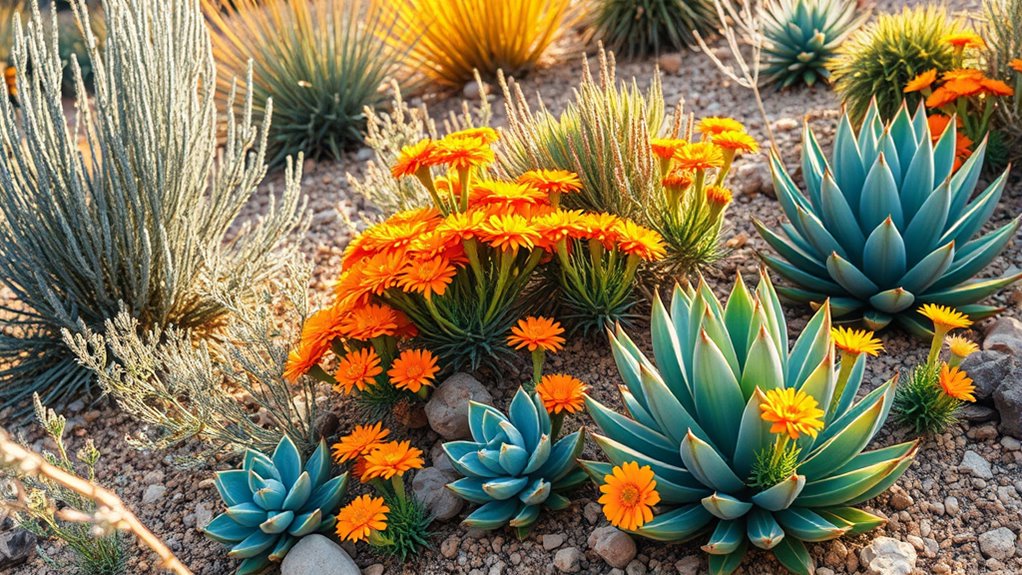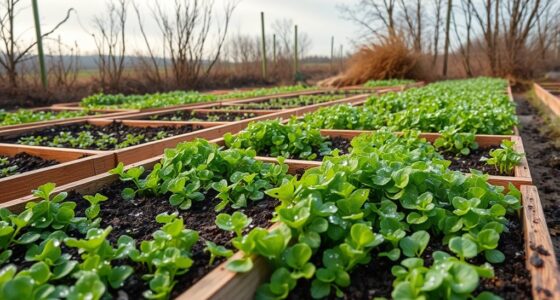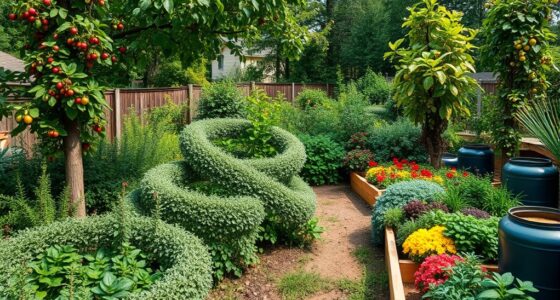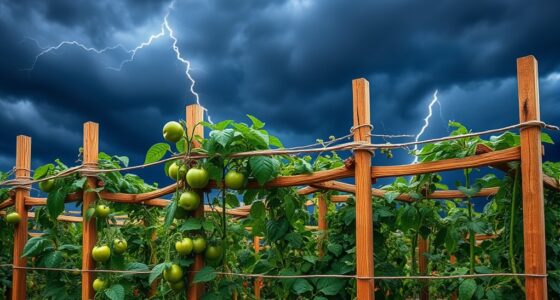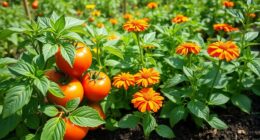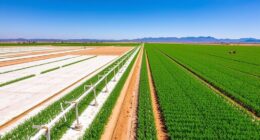If you're looking to thrive in a dry climate, consider these top five drought-resistant plants: Catmint offers aromatic blooms and attracts pollinators; Lavender adds stunning purple flowers and delightful scent; Russian Sage provides striking color with minimal upkeep; California Poppy brightens your garden with vibrant hues and self-seeds easily; and Yarrow's resilience and flat-topped clusters are perfect for low-water gardens. There's plenty more to discover about these fantastic plants and their care!
Key Takeaways
- Catmint is a drought-tolerant perennial that attracts pollinators and thrives in hardiness zones 3 to 8 with minimal maintenance.
- Lavender offers aromatic purple flowers, thrives in dry, well-drained soil, and is low maintenance, suitable for hardiness zones 5 to 10.
- Russian Sage grows 2 to 5 feet tall, flourishes in full sun, and requires little watering, making it ideal for low-water gardens.
- California Poppy is a vibrant annual that self-seeds, prefers poor soil, and attracts pollinators, thriving in dry climates with minimal watering.
- Yarrow is a hardy perennial that adapts well to poor soil, requires minimal maintenance, and features attractive blooms for pollinators in zones 3 to 11.
Catmint (Nepeta X Faassenii)

If you're looking for a resilient plant to thrive in dry conditions, Catmint (Nepeta x faassenii) is an excellent choice. This drought-tolerant perennial flourishes in hardiness zones 3 to 8, growing 1 to 3 feet tall and wide, perfect for borders, rock gardens, or containers.
Catmint loves full sun and can handle various soil types, showcasing its hardy nature. From early summer to early fall, you'll enjoy its aromatic flowers that attract butterflies and bees, adding beauty to your garden.
Best of all, it's low maintenance and can withstand both heat and drought, making it an ideal choice for xeriscaping. Plant Catmint and watch your garden thrive with minimal effort.
Lavender (Lavandula Spp.)
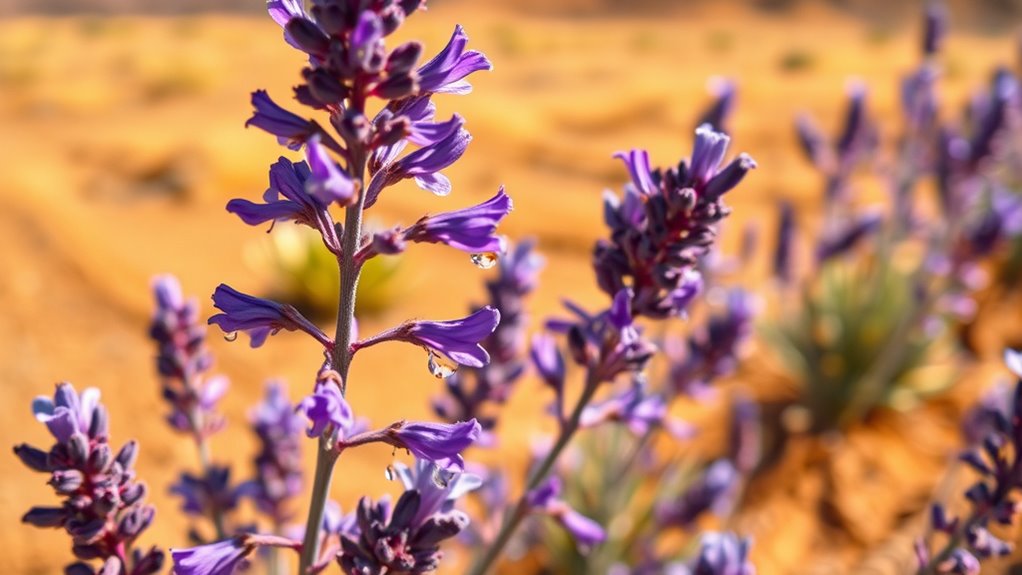
Lavender (Lavandula spp.) is a must-have for any drought-prone garden, flourishing in hardiness zones 5 to 10. This drought-tolerant aromatic plant thrives in full sun and well-drained soil, making it perfect for dry conditions.
With its stunning purple flowers blooming in summer, lavender attracts essential pollinators like bees and butterflies, enhancing your garden's ecosystem. Its low maintenance requirements mean you won't need to water it often once established, saving you time and effort.
Reaching heights of 1 to 3 feet and spreading 1 to 5 feet wide, lavender adds beautiful structure to your landscape. Plus, its fragrant foliage and flowers offer culinary uses, making it a versatile choice for any garden enthusiast.
Russian Sage (Perovskia Atriplicifolia)
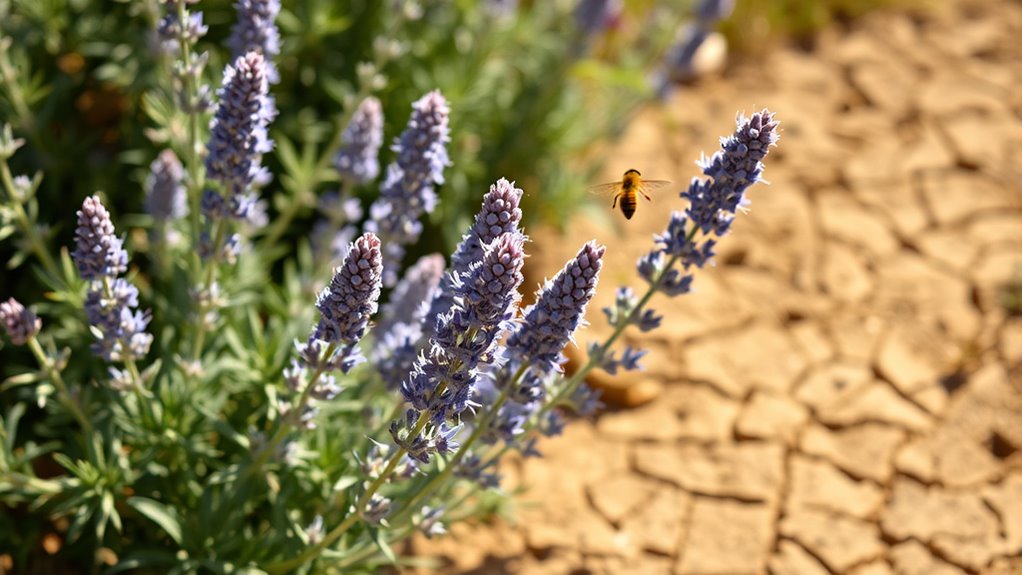
While many plants struggle in arid conditions, Russian Sage (Perovskia atriplicifolia) thrives, making it a standout choice for drought-resistant gardens.
This hardy perennial flourishes in full sun and well-drained soils, growing between 2 to 5 feet tall. With its striking purple blooms from mid-summer to early fall, it adds vibrant color while attracting pollinators like bees and butterflies.
The aromatic foliage not only enhances your garden's scent but also requires minimal maintenance, rarely needing supplemental watering once established.
Ideal for low-water gardens, Russian Sage tolerates poor soil conditions, making it perfect for xeriscaping and naturalized settings.
Embrace this resilient plant, and enjoy its beauty with less effort!
California Poppy (Eschscholzia Californica)
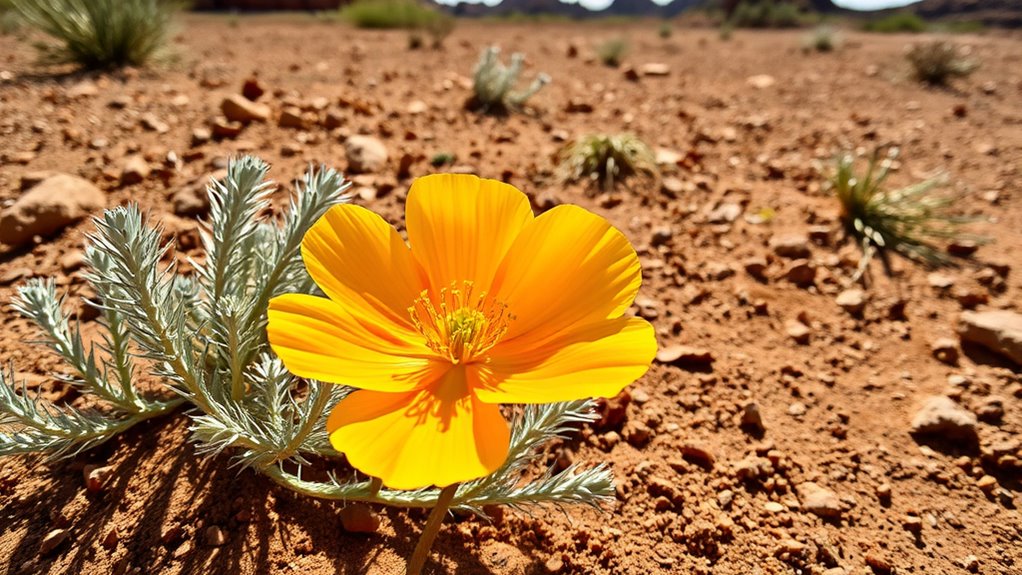
As you explore drought-resistant options for your garden, the California Poppy (Eschscholzia californica) stands out with its vibrant orange and yellow blooms. This hardy annual thrives in full sun and poor, well-drained soil, making it perfect for dry climates. With a height of 12 to 18 inches, California Poppies spread easily and require minimal watering once established.
| Feature | Details | Benefits |
|---|---|---|
| Light Requirement | Full sun | Promotes vibrant blooms |
| Soil Preference | Poor, well-drained soil | Low-maintenance growth |
| Attracts Pollinators | Yes | Supports local wildlife |
These striking flowers self-seed, creating naturalized areas and adding a splash of color to your landscape while conserving water resources.
Yarrow (Achillea Spp.)
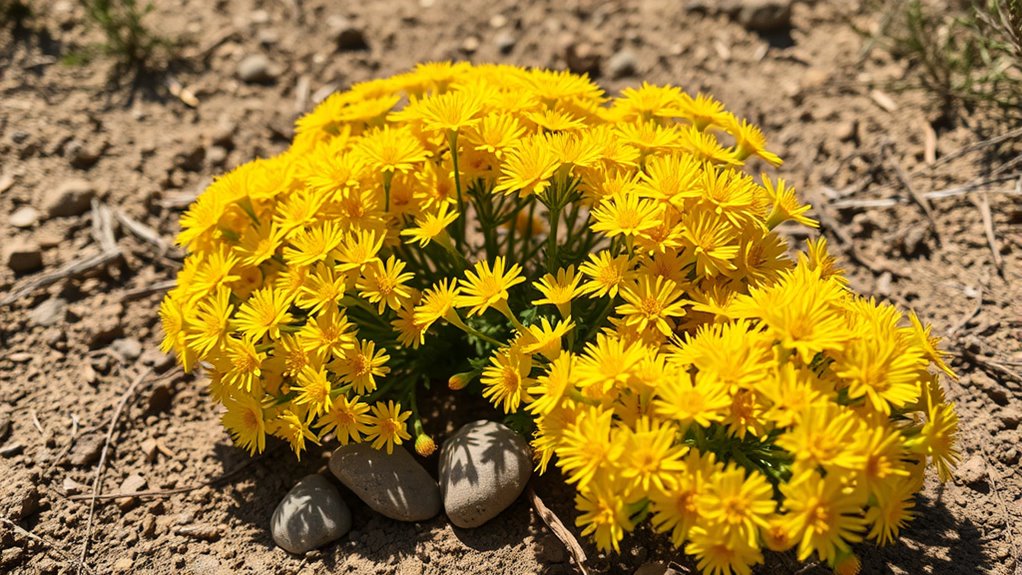
After admiring the vibrant California Poppy, consider adding Yarrow (Achillea spp.) to your garden.
This hardy perennial thrives in hardiness zones 3 to 11, making it versatile for various climates. Yarrow is a drought-tolerant plant that prefers full sun, growing 1 to 3 feet tall and 2 to 3 feet wide.
Its distinctive flat-topped clusters of summer blooms attract pollinators like butterflies and bees, enhancing your garden's biodiversity. Plus, yarrow adapts well to poor soil conditions and requires minimal maintenance once established, making it an excellent choice for low-water gardens.
The plant's fern-like foliage adds ornamental value while remaining resilient in dry conditions. Embrace yarrow for a beautiful, sustainable landscape!
Frequently Asked Questions
Which Plant Can Survive in Extremely Dry Conditions?
If you're looking for a plant that can survive in extremely dry conditions, consider the Agave Blue Glow. It thrives in full sun and needs minimal watering once established.
Another excellent choice is the Yucca filamentosa, which can reach heights of 4 to 8 feet and is perfect for xeriscaping.
Both options not only endure drought but also add unique beauty to your landscape without demanding much maintenance.
What Is the Most Drought-Resistant Plant?
When you consider the most drought-resistant plant, think of tough, tenacious varieties like succulents.
These stellar survivors, such as stonecrop, store water and thrive in arid environments.
Agave species, particularly Agave Blue Glow, also shine with their ability to endure minimal moisture.
Lavender's lovely blooms flourish in sandy soils, while Russian sage and yarrow add beauty and resilience to your garden.
Choosing such plants will guarantee your landscape thrives even in dry conditions.
What Plants Need the Least Amount of Water?
If you're looking for plants that need the least amount of water, consider options like succulents or hardy perennials.
You can choose varieties such as sedum or agastache, which thrive with minimal moisture.
Lavender and yarrow are also great choices, as they not only tolerate dry conditions but also attract pollinators.
Which Plant Will Most Likely Survive a Long Drought?
When the sun blazes like a thousand torches, you need a plant that can withstand the heat. Among the toughest contenders, the Agave Blue Glow stands out.
Its thick, fleshy leaves store water, allowing it to thrive in the harshest droughts. You'll find it's not just surviving; it's thriving, adding striking beauty to your landscape with minimal care.
Conclusion
Incorporating these drought-resistant plants into your garden isn't just a smart choice; it's a bold statement of resilience against dry climates. Imagine vibrant blooms and lush greenery thriving despite the scorching sun, proving that beauty can flourish even in adversity. By choosing Catmint, Lavender, Russian Sage, California Poppy, and Yarrow, you're not only conserving water but also creating an oasis that showcases nature's ability to adapt and thrive. Ready to transform your outdoor space? Let's get planting!

